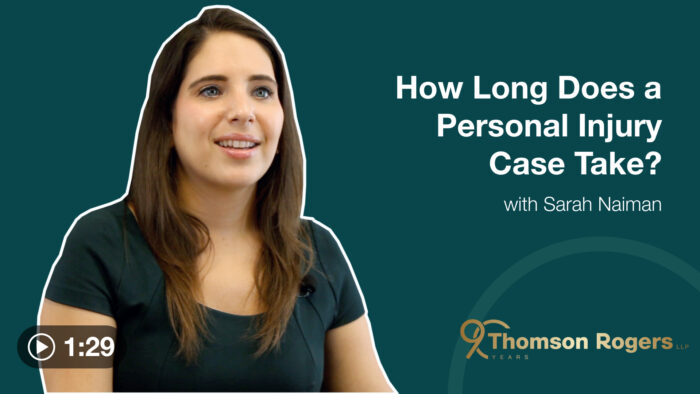LITIGATING OUT-OF-ONTARIO ACCIDENT CLAIMS
May 5, 2014

RECENT COURT DECISIONS LAY OUT THE FACTORS DETERMINING JURISDICTION, AND HOW THEY APPLY
We love our cars. With the summer driving season fast approaching, many of us soon will be packing them up and leaving home to head down East, out West or over the border on summer vacation.
Statistics Canada data shows that in July – August Canadians make more than 5.3 million same-day car trips and almost 2.3 million trips of one or more nights to the United States.
With this volume of traffic outgoing, it is inevitable that some Ontarians will be injured in car accidents in other jurisdictions.
Once injured, usually after relatively brief periods of treatment out of province, accident victims return to Ontario to undergo the bulk of their rehabilitation and resume what they can of their normal lives. It is also in Ontario where they make their claims to their own Ontario no-fault benefit insurers.
In these circumstances, the most convenient forum in which to litigate motor vehicle accident claims is almost always Ontario. It’s not only the residence of the plaintiff, but also his or her family members, friends and relatives, teachers or employers, treating doctors, rehabilitation therapists and others, many of whom will have to testify to prove the plaintiff’s damages. Family members or friends often are witnesses to the accident, sometimes having been in the car when the accident occurred. However, despite Ontario being the most convenient forum, the province’s courts don’t always have jurisdiction over the claims.
In Club Resorts Ltd. v. Van Breda [2012] S.C.J. No. 17, the Supreme Court set out four presumptive factors that would allow an Ontario court to assume jurisdiction for foreign accident cases (subject to a defendant’s ability to rebut any presumption). These four factors — the defendant is resident in Ontario or carries on business in Ontario, or the tort was committed in Ontario or a contract connected with the dispute was made in Ontario — may well be absent in many car accident cases. Therefore, if a foreign defendant does not voluntarily submit to the jurisdiction of the province, the plaintiff may well be forced to bring his or her claim out of province.
Ontario courts have recently had opportunity to consider the effect of Van Breda with respect to two car accidents occurring in the state of New York.
In the first case, Paraie v. Cangemi [2012] O.J. No. 5390, an Ontario motorist was struck from behind by a car owned and operated by a New York resident. The Ontario plaintiff brought a claim against the New York motorist and also his own Ontario automobile insurer with respect to uninsured and underinsured motorist coverage. The plaintiff argued that the claim against his own insurer was with respect to a contract that was connected with the dispute which was made in the province and, therefore, the Ontario court should accept jurisdiction.
Justice Lederer held that a plaintiff should not be able to “boot strap” defendants into an action in Ontario by relying on a contingent claim against their own insurer which just happens to be resident in Ontario. The action was therefore stayed.
In the second case, Cesario v. Gondek [2012] O.J. No. 5644, an Ontario motorist had the misfortune to be involved in two motor vehicle accidents four weeks apart. The first accident occurred in New York and the second accident occurred in Ontario. The plaintiff sued the New York and Ontario motorists and his own insurer, all in the same action, claiming that the injuries received in the two accidents could not be separately identified and assessed.
Justice Mark Edwards held that as long as one defendant (not necessarily the moving defendant) was domiciled in the province, Ontario would have jurisdiction. Significant to this ruling was Justice Edwards’ finding that if Ontario did not assume jurisdiction then the plaintiffs might be forced to litigate three separate actions, one in New York and two in Ontario. This course might result in the “unjust prospect of inconsistent verdicts”. Justice Edwards also considered as a significant factor that the New York defendant’s insurer had registered in Ontario with the Financial Services Commission of Ontario. It should be noted that over 800 American and Canadian Insurers have registered with FSCO. Therefore, in this case, the Ontario court remained seized of the claim.
Practically speaking, plaintiff’s counsel, once retained with respect to an out-of-province accident, should immediately retain a lawyer in the state or province where the accident occurred. This out-of-province counsel will have to advise with respect to the foreign jurisdiction’s substantive law. In Tolofson v. Jensen [1993] 3 S.C.R. No. 1022, the Supreme Court held that, generally, the substantive law of the place where the accident/tort occurred will be applied to the case, even when the case is litigated in another jurisdiction. However, the procedural rules of the jurisdiction where the case is proceeding will govern all procedural steps. Foreign jurisdictions can have very different substantive laws that govern car accident cases. Substantive laws include limitation periods, heads of damages recoverable and liability for, and the amount of, interest payable. Especially with respect to limitation periods, Ontario lawyers must be fully informed so that they do not inadvertently miss a foreign limitation period (which as a substantive matter of law would be applied in the Ontario action).
Additionally, Ontario counsel may well want to instruct counsel in the foreign jurisdiction to issue a claim in that jurisdiction. This foreign claim would only be served and prosecuted if the Ontario court does not accept jurisdiction. It would also be prosecuted if a foreign defendant refused to submit to the Ontario jurisdiction and it was anticipated that there may be difficulty enforcing an Ontario judgment in that foreign jurisdiction.
In any event, with summer on its way, Ontario lawyers should be prepared to be retained to prosecute claims with extra-jurisdictional complications.
View PDF version: Accident Benefit Reporter | Volume 15, Issue 1 | May 2014
Share this






